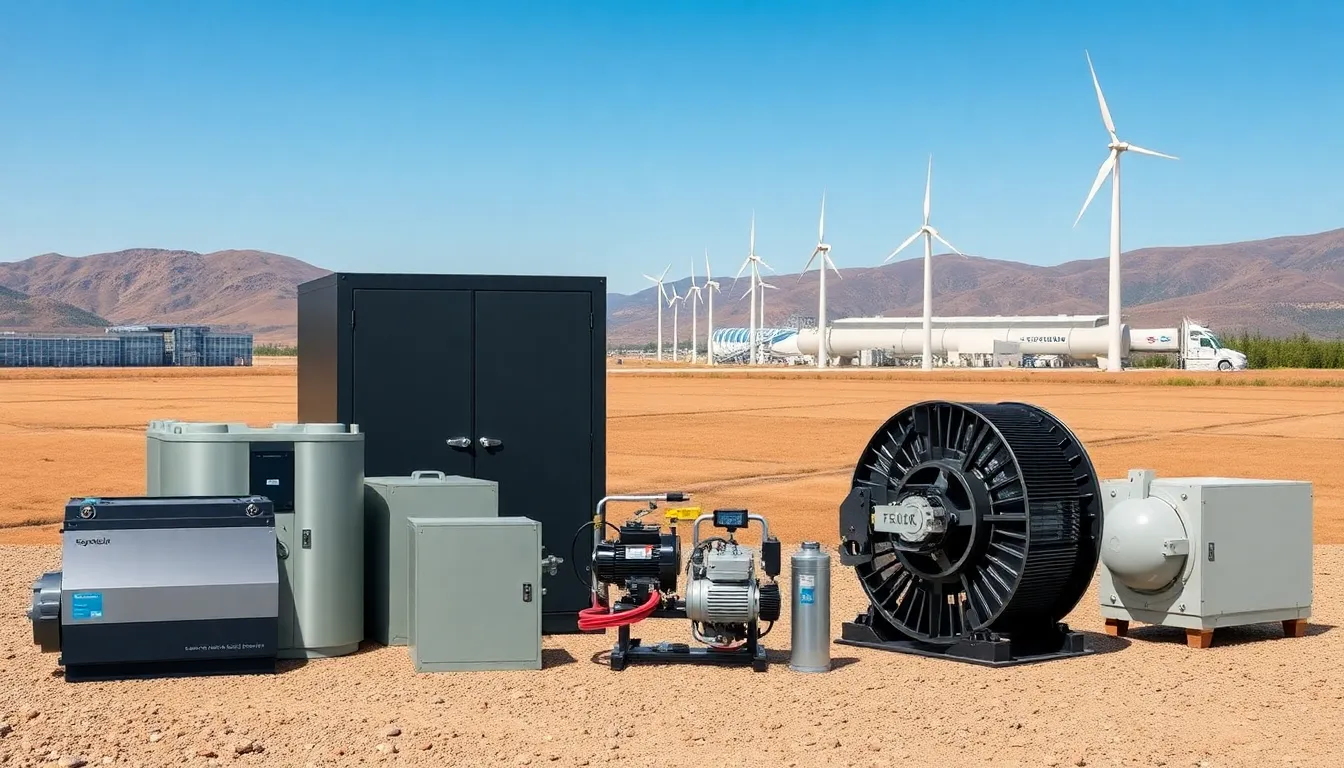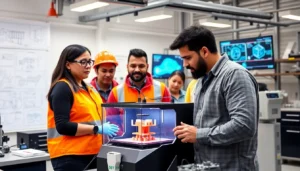Table of Contents
ToggleEnergy storage innovations are shaking up the way we think about power. Imagine a world where your phone charges faster than your coffee brews, and your home runs on sunshine even when the sun’s taking a break. With advances in technology, this isn’t just a dream; it’s becoming a reality.
Overview of Energy Storage Innovations
Energy storage innovations play a crucial role in shaping the future of energy management. Battery technology stands at the forefront, showcasing advancements in lithium-ion and solid-state batteries. Companies have invested heavily in research, driving energy density improvements while reducing costs to make these technologies more accessible.
Flexible storage solutions have emerged, allowing integration with diverse energy sources. Liquid battery systems enable users to store renewable energy efficiently. Such systems can handle large-scale energy demands, making them ideal for grid applications.
Innovations in thermal energy storage provide another layer of efficiency. These systems capture excess heat for later use, helping to balance supply and demand in real-time. Thermal storage technologies are particularly beneficial for industries with high energy consumption.
Furthermore, advancements in compressed air energy storage offer promising options. By converting electricity into compressed air, users can store energy for later use. This method has great potential for long-duration energy storage, supporting renewable energy systems when demand peaks.
Research into flow batteries continues to grow, focusing on scalability and longevity. These batteries operate on liquid electrolytes, allowing for easy capacity adjustments. Safety and environmental concerns are also being addressed with newer materials and designs.
Grid-connected energy storage systems are gaining traction, enhancing grid resilience and reliability. They support load balancing and prevent outages during peak usage. Enhanced software integration optimizes performance, ensuring that users can maximize the benefits of stored energy.
Technological advancements signal a future characterized by smart energy solutions, creating a sustainable energy landscape that benefits everyone.
Types of Energy Storage Technologies

Energy storage technologies play a crucial role in optimizing energy management and improving accessibility. Various types of storage solutions have emerged, providing unique advantages.
Batteries
Batteries, particularly lithium-ion and solid-state batteries, dominate the energy storage landscape. Innovations have focused on enhancing energy density, which increases capacity while reducing costs. Leading companies pour substantial investments into research, aiming to make these advancements cost-effective and widely available. Flow batteries also receive attention for their scalability and longevity, proving suitable for large renewable projects. With these continuous enhancements, batteries are becoming a mainstay for both residential and commercial energy solutions.
Supercapacitors
Supercapacitors offer rapid charging and discharging capabilities, maintaining efficiency during performance. These devices excel in applications requiring quick bursts of energy, such as in electric vehicles and renewable energy integration. Their lifespan surpasses traditional batteries, allowing for numerous charge cycles without significant performance degradation. Research focuses on reducing costs while increasing energy storage levels, making them essential for innovative energy management strategies. As technology progresses, supercapacitors play a vital role in enhancing grid stability and supporting intermittent renewable sources.
Flywheel Storage
Flywheel storage systems utilize mechanical energy to provide rapid response capabilities. They store energy in the form of rotational motion, releasing it quickly when demand spikes. Flywheels contribute to grid stability by balancing short-term fluctuations. Their robustness allows for long operational lifespans with minimal maintenance. Ongoing development aims to increase energy capacity while decreasing costs, positioning flywheels as a reliable solution for industrial applications and reinforcement of energy infrastructures.
Recent Innovations in Energy Storage
Recent advancements in energy storage technologies lead to transformative possibilities in the energy sector. These innovations contribute significantly to renewable energy integration and grid resilience.
Solid-State Batteries
Solid-state batteries represent a significant leap in energy storage. Unlike conventional lithium-ion batteries, these utilize a solid electrolyte, enhancing safety and energy density. Research indicates that solid-state batteries can achieve energy densities up to 500 Wh/kg, doubling that of traditional options. Companies, such as Toyota and QuantumScape, invest heavily in perfecting this technology. They focus on scalability, aiming for mass production within the next few years. The rapid charging capability of solid-state batteries positions them as ideal for electric vehicles and portable electronics. Many developers see this innovation as pivotal in making electric mobility more accessible.
Liquid Metal Batteries
Liquid metal batteries bring a unique approach to energy storage solutions. Composed of liquid electrodes and a molten salt electrolyte, they provide excellent scalability. These batteries excel in charging and discharging efficiency, responding rapidly to grid demands. U.S.-based startup Ambri is at the forefront, targeting long-duration energy storage applications. With a potential cycle life of over 10,000 cycles, liquid metal batteries are poised to support renewable energy sources effectively. Their inherent design minimizes safety risks often associated with conventional batteries. Researchers estimate that liquid metal batteries can reduce costs and improve overall performance in large-scale storage systems.
Challenges Facing Energy Storage Innovations
Energy storage innovations face significant challenges impacting their adoption and effectiveness. Scalability and cost represent two primary hurdles in advancing these technologies.
Scalability Issues
Scalability remains a crucial concern for energy storage innovations. Existing technologies often struggle to meet the growing demand for renewable energy storage. Lithium-ion batteries, while widely used, face challenges in scaling up for large applications. Solid-state batteries offer enhanced safety but encounter production hurdles, limiting widespread deployment. Liquid metal batteries show promise for scalability but require further development to maximize efficiency. Flow batteries present opportunities for large-scale renewable projects yet depend on infrastructure improvements. Creatively addressing these scalability issues will be vital for accommodating increasing energy needs.
Cost Considerations
Cost considerations significantly influence the future of energy storage technologies. High manufacturing costs for advanced batteries hinder market entry and large-scale adoption. Lithium-ion batteries, although cheaper than before, still incur expenses that challenge widespread use. Solid-state batteries promise superior performance but come with substantial production costs that impact pricing. Flow batteries offer longer life but face economic barriers due to the complexity of their systems. Investors and researchers focus on reducing costs through innovative materials and production methods. Effective management of these cost factors will enhance the viability of energy storage solutions in the market.
Future Trends in Energy Storage
Future trends in energy storage point toward enhanced integration with renewable energy sources and advancements in materials science. These developments promise to improve efficiency, lower costs, and create sustainable solutions.
Integration with Renewables
Integration with renewables plays a pivotal role in energy storage advancements. Solar and wind energy systems benefit significantly from robust storage solutions, allowing excess energy to be captured during peak production. Energy storage systems support the intermittent nature of these resources, enabling consistent power availability. Grid-connected storage enhances the reliability of renewable energy, reducing dependency on fossil fuels. As more systems become scalable, energy transition accelerates, fostering sustainability and reducing greenhouse gas emissions.
Advances in Materials Science
Advancements in materials science drive progress in energy storage technologies. Researchers focus on developing new materials that improve battery performance, energy density, and longevity. Solid-state electrolytes stand out for their safety and efficiency compared to traditional liquid electrolytes. Lithium-sulfur batteries offer potential with a theoretical energy density that exceeds 600 Wh/kg. Innovative composites and nanomaterials enhance the capacity of existing battery types, providing faster charging and longer cycle life. These breakthroughs pave the way for widespread adoption of electric vehicles and portable energy solutions.
Energy storage innovations are shaping a new era in power management and consumption. As technologies evolve and costs decrease, the adoption of advanced energy storage solutions will become more widespread. With improved battery technologies and flexible storage options, the future holds the promise of enhanced energy efficiency and sustainability.
The ongoing research into scalable solutions and novel materials is crucial for overcoming current challenges. By integrating these innovations with renewable energy sources, it’s possible to create a more resilient and reliable energy grid. This transformation not only supports the transition to cleaner energy but also paves the way for a smarter, more sustainable future. The journey of energy storage is just beginning, and its potential is limitless.







